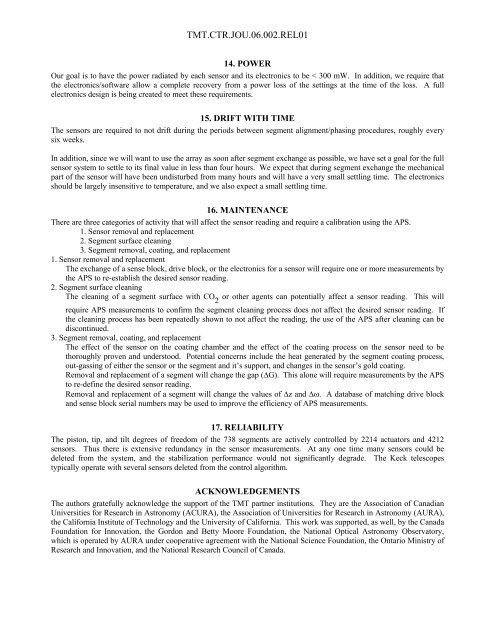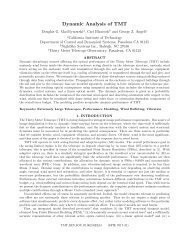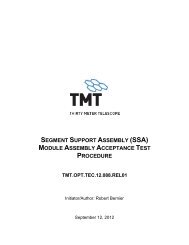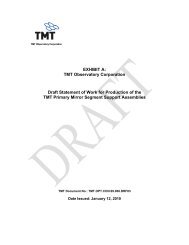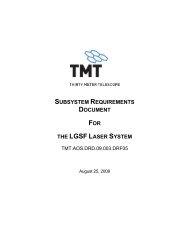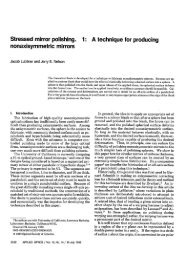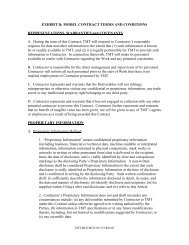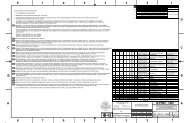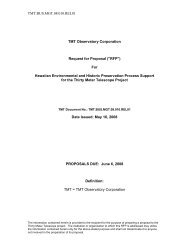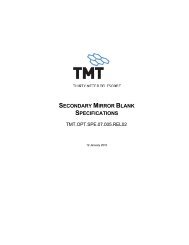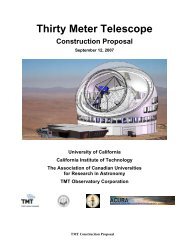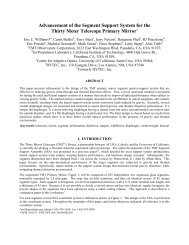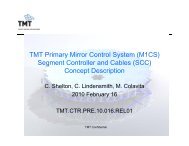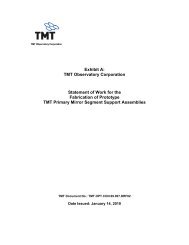An Edge Sensor Design for the TMT - Thirty Meter Telescope
An Edge Sensor Design for the TMT - Thirty Meter Telescope
An Edge Sensor Design for the TMT - Thirty Meter Telescope
You also want an ePaper? Increase the reach of your titles
YUMPU automatically turns print PDFs into web optimized ePapers that Google loves.
<strong>TMT</strong>.CTR.JOU.06.002.REL01<br />
14. POWER<br />
Our goal is to have <strong>the</strong> power radiated by each sensor and its electronics to be < 300 mW. In addition, we require that<br />
<strong>the</strong> electronics/software allow a complete recovery from a power loss of <strong>the</strong> settings at <strong>the</strong> time of <strong>the</strong> loss. A full<br />
electronics design is being created to meet <strong>the</strong>se requirements.<br />
15. DRIFT WITH TIME<br />
The sensors are required to not drift during <strong>the</strong> periods between segment alignment/phasing procedures, roughly every<br />
six weeks.<br />
In addition, since we will want to use <strong>the</strong> array as soon after segment exchange as possible, we have set a goal <strong>for</strong> <strong>the</strong> full<br />
sensor system to settle to its final value in less than four hours. We expect that during segment exchange <strong>the</strong> mechanical<br />
part of <strong>the</strong> sensor will have been undisturbed from many hours and will have a very small settling time. The electronics<br />
should be largely insensitive to temperature, and we also expect a small settling time.<br />
16. MAINTENANCE<br />
There are three categories of activity that will affect <strong>the</strong> sensor reading and require a calibration using <strong>the</strong> APS.<br />
1. <strong>Sensor</strong> removal and replacement<br />
2. Segment surface cleaning<br />
3. Segment removal, coating, and replacement<br />
1. <strong>Sensor</strong> removal and replacement<br />
The exchange of a sense block, drive block, or <strong>the</strong> electronics <strong>for</strong> a sensor will require one or more measurements by<br />
<strong>the</strong> APS to re-establish <strong>the</strong> desired sensor reading.<br />
2. Segment surface cleaning<br />
The cleaning of a segment surface with CO 2<br />
or o<strong>the</strong>r agents can potentially affect a sensor reading. This will<br />
require APS measurements to confirm <strong>the</strong> segment cleaning process does not affect <strong>the</strong> desired sensor reading. If<br />
<strong>the</strong> cleaning process has been repeatedly shown to not affect <strong>the</strong> reading, <strong>the</strong> use of <strong>the</strong> APS after cleaning can be<br />
discontinued.<br />
3. Segment removal, coating, and replacement<br />
The effect of <strong>the</strong> sensor on <strong>the</strong> coating chamber and <strong>the</strong> effect of <strong>the</strong> coating process on <strong>the</strong> sensor need to be<br />
thoroughly proven and understood. Potential concerns include <strong>the</strong> heat generated by <strong>the</strong> segment coating process,<br />
out-gassing of ei<strong>the</strong>r <strong>the</strong> sensor or <strong>the</strong> segment and it’s support, and changes in <strong>the</strong> sensor’s gold coating.<br />
Removal and replacement of a segment will change <strong>the</strong> gap (∆G). This alone will require measurements by <strong>the</strong> APS<br />
to re-define <strong>the</strong> desired sensor reading.<br />
Removal and replacement of a segment will change <strong>the</strong> values of ∆z and ∆ω. A database of matching drive block<br />
and sense block serial numbers may be used to improve <strong>the</strong> efficiency of APS measurements.<br />
17. RELIABILITY<br />
The piston, tip, and tilt degrees of freedom of <strong>the</strong> 738 segments are actively controlled by 2214 actuators and 4212<br />
sensors. Thus <strong>the</strong>re is extensive redundancy in <strong>the</strong> sensor measurements. At any one time many sensors could be<br />
deleted from <strong>the</strong> system, and <strong>the</strong> stabilization per<strong>for</strong>mance would not significantly degrade. The Keck telescopes<br />
typically operate with several sensors deleted from <strong>the</strong> control algorithm.<br />
ACKNOWLEDGEMENTS<br />
The authors gratefully acknowledge <strong>the</strong> support of <strong>the</strong> <strong>TMT</strong> partner institutions. They are <strong>the</strong> Association of Canadian<br />
Universities <strong>for</strong> Research in Astronomy (ACURA), <strong>the</strong> Association of Universities <strong>for</strong> Research in Astronomy (AURA),<br />
<strong>the</strong> Cali<strong>for</strong>nia Institute of Technology and <strong>the</strong> University of Cali<strong>for</strong>nia. This work was supported, as well, by <strong>the</strong> Canada<br />
Foundation <strong>for</strong> Innovation, <strong>the</strong> Gordon and Betty Moore Foundation, <strong>the</strong> National Optical Astronomy Observatory,<br />
which is operated by AURA under cooperative agreement with <strong>the</strong> National Science Foundation, <strong>the</strong> Ontario Ministry of<br />
Research and Innovation, and <strong>the</strong> National Research Council of Canada.


